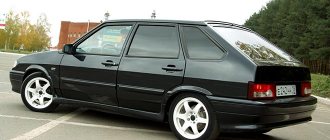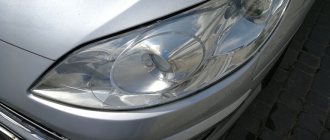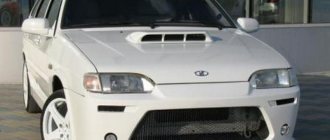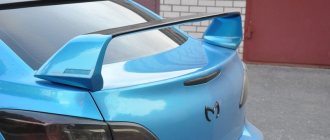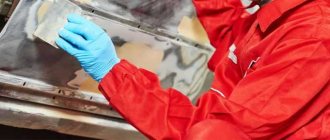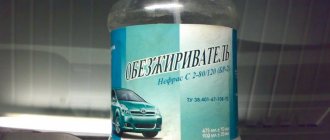Gluing carbon film to a car using dry and wet methods
There are two ways to stick the film on the surface. If you are a beginner, it is better to consult with professionals; they will tell you the right way to use the selected material. There are two methods: dry and wet. To determine the benefits, it is necessary to characterize each:
- Dry method. The carbon film is applied to a clean, completely dry and grease-free surface and secured with magnets. Cut the blanks with sharp scissors, leaving about 3 cm at the edges, make an incision and remove the protective layer. The procedure must be done slowly, moving from the center to the edges. Use a special squeegee to smooth the surface without leaving bubbles. If they still exist, you can get rid of them with a hairdryer. Repeat the manipulation with each part, secure the remaining pieces on the inside, use only high-quality glue.
- Wet method. First, you should clean and degrease the surface in the same way as with the dry method. Then a spray bottle is additionally used. With its help, the soap solution must be sprayed evenly over all parts. You need to stick it carefully, stretch the film slightly, you can use a hairdryer to increase elasticity. This method is used for uneven parts. Tuning is ready after the solution under the film has dried.
Gluing carbon film to a car using dry and wet methods
Creating a Matrix
Reverse side of the hood
Separating the matrix from the hood
After the matrix has completely hardened, it must be released.
For this purpose, there are special wedges of different sizes and different hardnesses. These plastic wedges are convenient to use because they will not damage the edge, unlike screwdrivers, spatulas and other tools. In our case, it is not too important not to damage the edges, since we have an additional edge around the perimeter of the hood. It is necessary to cut off a few centimeters of this edge so that the junction of the two halves of the matrices is clearly visible. First you need to mark a cut line around the entire perimeter of the hood. A jigsaw is used for cutting. Use a tungsten carbide blade. Insert wedges or any other flat tool around the perimeter of the die and gently push inward. This needs to be done gradually, moving around the perimeter. Sometimes you may need to use a hammer to lightly tap the wedges or other tool. Special wedges of different sizes for separating the fiberglass matrix or hood.
Large panels and matrices are sometimes difficult to separate, even after separating the edges. This is affected by slight adhesion of the cast mold and static. If disconnection is difficult, you can apply compressed air or pressurized water into the gap between the matrix and the breadboard to help disconnect the matrix.
In this form, the matrix can be used as is, but to give an additional smoothness to the surface, you need to sand the surface with P1200 sanding paper and water. This stage will remove minor imperfections on the surface and make the surface perfectly smooth. Thus, the form filled in this matrix will not imprint small irregularities in the surface of the matrix.
How to cover individual car parts with carbon fiber
Cars that have individual carbon elements: hood, mirrors or spoiler look very interesting. The contrast with the glossy paint makes them look like expensive sports cars.
Hood
The carbon hood looks very impressive and gives the car a brutal look.
To make it easier to cover the hood, dismantle it. Position the hood so that it is easy to approach; the optimal height is at the level of your hands. It's okay if you don't want to separate the hood: you can just open it slightly.
The general principle of pasting is the same as for a whole car: the surface must be clean and free of grease. All other steps are performed identically.
The hoods of modern cars have an unusual shape and pronounced curves. Sometimes in such bends it is quite difficult to smooth out the film using the wet method. Therefore, stock up on both soap solution and a hairdryer. In places where there are kinks, thoroughly heat the film, pressing it tightly to the surface. For ease, use a small spatula or something like a hard plastic credit card. Carefully consider all design elements.
In general, covering a hood is much easier and faster than a whole car. And the occurrence of air bubbles is much less likely. So don't be afraid to do this procedure yourself.
Side mirrors
Don't forget to cover the side mirrors with carbon film
It is even easier to cover mirrors with carbon film than the hood. To do this, you don’t even need to separate their car. Simply cut off the required amount of film and spread it over a grease-free surface. You can use it either dry or wet. Smooth the film using movements from the center to the edges. Cut off all the excess and enjoy the stylish appearance of your car.
Spoiler
Covering the spoiler is also not difficult. The main thing is to work out all the bends and avoid bubbles. It is best to use a durable film with a thickness of at least 200 microns, as it will stretch less. For ease of operation, the spoiler can be removed.
When gluing this part, many people have a logical question: where to make the joint? It is best to try to make it on the edge, so it will be less noticeable.
Carbon imitation parts will add a special touch to your car.
Plastic interior parts
Carbon film is suitable for finishing not only the exterior, but also the interior of the car.
Carbon film can be used to cover a car not only on the outside, but also on the inside.
Be sure to remove all plastic parts of the interior that you are going to cover. After this, you need to decide on the dimensions: the easiest way to do this is by attaching the element to the paper side of the film and making the necessary notes. Remember that you need some margin to secure the edges. If parts have holes, mark them too. Cut out the resulting pattern.
The part should be washed, dried and degreased. Be very careful: the film should not be stretched too much. When the material is completely smoothed, carefully tuck the edges and secure them on the inside. If you have made too much stock, use a utility knife to cut off the excess.
Wrapping a car at home is not the most difficult task, especially if you have help. But to be on the safe side, it’s better to practice on mirrors, spoilers or other small parts. This will help save money when purchasing large quantities of material. If everything goes well, you can try to cover the entire car.
Well, if the result obtained is not quite what you would like, don’t despair. Most workshops now provide this service. They will quickly and efficiently create a new coating for you and even give you a guarantee.
Since its inception in the automotive industry, carbon has been considered a "luxury" material, used only by street racers. Tuning using carbon fiber not only allows you to give the car a unique appearance, but also reduces the weight of the car. This gave them an advantage in races where an extra kilogram of car weight could decide the outcome of the race.
Soon other car enthusiasts who were far from racing began to appreciate the benefits of carbon fiber. Finishing with carbon fiber material allows you to effectively distinguish your car from the crowd. But carbon is not the best material for city driving and highway driving. With the development of auto vinyl technology, such a service as wrapping with carbon film has become in demand. Professional carbon fiber lining is no different in appearance from natural carbon fiber.
Making a matrix
Making a matrix with your own hands:
Now let's move on to the inside. All cracks between the amplifiers must be carefully covered with plasticine. Otherwise, the procedure is completely similar to that already described above. Since the two parts of the matrix will subsequently be connected, for the inside it is enough to put 2-3 layers of fiberglass with a density of 600 g/sq. m. Do not forget to wall up the fastenings and the latch.
The manufacture of the matrix ends with the connection of two parts. Polyester resin with the addition of aerosil is used as glue. For a quality connection, the surface must be thoroughly degreased. After final adjustment, apply adhesive and then press the two parts tightly. Leave the matrix for 1-2 days for complete setting.
Painting or pasting, which is more profitable?
Anti-gravel armored film will last for 5–10 years. It is thicker than the factory paint coating and reliably protects it from damage. If you completely cover a car with such a film, you will have to pay about 150–180 thousand rubles at the salon. If you protect individual areas, the cost will be less. It is very difficult to cover a car with polyurethane armored film yourself.
Vinyl film is thinner, and on complex elements where it stretches, its thickness decreases by another 30–40%. Its choice is wider, and pasting is easier than with polyurethane film. The cost of a complete car wrap will cost about 90–110 thousand rubles. The service life of vinyl film is less and is 3–5 years.
High-quality car painting also requires a lot of expense. Everything can be done correctly only at a specialized station, where there is a chamber with the ability to regulate the air temperature and equipment. The price starts from 120–130 thousand, it all depends on the materials used.
When preparing for painting, you will have to remove a lot of hanging elements, and this takes a lot of time. The thickness of the paint layer will be greater than that of the factory coating and is about 200–250 microns. The advantage of painting is that there is a thicker layer of varnish, so several abrasive polishes can be done.
You won’t be able to paint a car with high quality on your own. If you choose between painting and vinyl, the first option has a longer service life. If you cover some parts with vinyl film, it will cost less than painting them. If the entire body is covered with vinyl, the price is comparable to painting it. High-quality painting will last no less than the factory coating.
What is carbon?
Before moving directly to the film material, which is mostly used in car tuning, you need to consider the original - real carbon fiber plastic, or carbon plastic. This is a composite - a material made from several types of raw materials.
Carbon is an innovative material: it is a fabric made of carbon threads with the addition of epoxy resins and rubber fibers. The peculiarity of the material is its original, recognizable texture, the reason is the unique interweaving of threads. The most popular option is still the “herringbone”.
Areas of application of carbon fiber reinforced plastic
Nowadays carbon is used in those industries that require materials that are elastic, super strong, but as light as possible. For example, carbon fiber has become indispensable in the aviation and space industries and in the production of prosthetics. The automotive industry is another “field of activity” for carbon fiber. Since this material is expensive, it is used only for premium models: automatic transmission handles, inserts for the steering wheel, panels and other decorative elements are made from carbon fiber.
Sports is another area of application for carbon fiber. Carbon is actively used for finishing the interiors and bodies of racing cars; the main parts of motorcycles, boats, snowmobiles, etc. are made from it. In this case, the main advantage of the material is the combination of “minimum weight and lightness.” Carbon is lighter than aluminum and steel: 20% and 40%, respectively. However, in strength it is not inferior to any alloy.
Disadvantages of carbon
Its high price is the most significant disadvantage of an almost flawless material, if we talk about car owners who passionately want to change the appearance of their “horse”. For this reason, not everyone can afford to tune a car with expensive carbon fiber, and many owners in Russia simply do not see the point in such expenses. There is one reason for these doubts: this is another drawback of natural material.
The original carbon has an “Achilles heel”: it is inability to withstand strong point impacts. Even a small stone thrown from under the wheel of a moving car can cause the replacement of a carbon-plastic element, which, given our “wonderful” (in most regions) roads, will turn into a very expensive pleasure. Damaged parts cannot be restored.
Material selection
For cars of this brand they can be made from:
- aluminum,
- become,
- fiberglass,
- carbon fiber.
The latter material is actively used in the production of tuning components.
Carbon is a composite material that consists of interwoven carbon strands held together by epoxy resin. A positive property of such threads is their high resistance to tearing. However, under the influence of compressive force they become very brittle. To eliminate brittleness, carbon fibers are mixed with rubber threads at a certain angle during weaving.
6D carbon film under varnish.
A few years ago, 4D carbon was considered the newest film. Unlike 3D vinyl, the shape of its cells is not rectangular, but rounded, which gives some depth. The beautiful glossy texture of 4D film looks especially impressive on curves. By the way, glossy carbon is still popular, because varnished films cannot replace it due to its large thickness.
By analogy with 5D vinyl, 6D carbon film under varnish differs from 4D only in the laminating coating. But it is this transparent layer that completely changes the perception: the effect of depth is greatly enhanced. At first glance, it is difficult to distinguish between real carbon fiber and 6D film. Moreover, the latter costs an order of magnitude lower. You no longer need to order the production of a carbon part just to decorate the interior: vinyl wrapping will cost less, and styling work will be completed in just a few hours.
Spoiler
This type of hood tuning protects the bumper from scratches and chips caused by small stones hitting it, and improves the aerodynamic properties of the car.
Also, such a spoiler prevents insects from hitting the bumper, for which it is popularly nicknamed a “fly swatter.” The spoiler is installed in five stages:
- The hood is opened, the film and covers are removed from the spoiler;
- The spoiler mounting bolts are loosened with a screwdriver;
- The spoiler is installed on the hood so that the edge of the hood fits into the lower bend of the bracket, and is centered along the edges of the hood;
- Tighten the screws on the spoiler bracket from one edge of the hood;
- The spoiler is pulled over the other edge of the hood until the rubber bands touch it, after which the remaining screws are tightened.
Carbon film colors.
Black 3D carbon film has become a classic material for car body styling. This film combines the severity of black color and the unusual three-dimensional carbon texture. Of course, black carbon film is a leader in performance and practical use among other vinyl. White carbon can only exist if it is a vinyl film because carbon fiber is black in color. The combination of a carbon pattern and white color will not leave any designer indifferent. Blue carbon film is good because it dilutes the boring color scheme, but does not attract unnecessary attention to the car. Silver carbon is universal. This film is often used to completely cover a car. But even more often, silver carbon film is used to dilute other colors. Red 3D carbon fiber film is rarely glued to the entire surface of the car. Basically, such vinyl emphasizes details. Less commonly used with other colors in the same proportion. Gold carbon film looks great in combination with black or on its own. Such car vinyl will certainly make the car more interesting and attractive. You rarely see pink color on a car body, and a car covered in pink carbon fiber is even rarer, which guarantees the envious gaze of many girls. On the other hand, pink carbon film is often used in the design of equipment: laptops, tablets, iPhones, etc. Orange car vinyl is glued if you are tired of the boring look of the car. The orange carbon film will constantly delight not only the owner of the car, but also those around him, with its bright and independent appearance. Dark gray carbon 3D film is successfully used for covering not only automotive parts, but also for styling furniture and household appliances. Anthracite-colored film looks good together with black and silver carbon fiber. Transparent carbon replaces the anti-gravel film. The car body parts covered with such vinyl acquire not only protection, but also a 3D carbon fiber texture. Cherry car film is combined with shades of red: burgundy, pink, fuchsia, raspberry. Available in silver, black or white carbon. Aluminum carbon has a lighter shade than silver film. The surface is more matte. It is convenient to combine it with a film for polished or corrugated aluminum. Green is quite rare among carbon-look films. Typically, such vinyl has a dark green tint or a bright light green color. Yellow carbon-3D vinyl film adds energy to the appearance of the car. Depending on the combination with other colors, you can get a more aggressive or calm design. The blue carbon-look film has a metallic sheen, which further adds expressiveness to this vinyl. Carbon film chameleon attracts attention with a double effect
The color variability and texture of 3D carbon make chameleon film an extremely unusual material. Pearlescent carbon is a win-win option for the design of women's cars. It doesn’t matter whether the body is completely covered with pearl film or combined with other colors, the result will be excellent. Brown carbon is recommended to be used in combination with colors such as light silver, dark gray or black. To create unusual solutions, chocolate-colored carbon fiber can be used together with pink or acid-green auto vinyl. Beige carbon 3D film is a good choice if you plan to get a calm and light car design
This color is often used in luxury cars. Purple 3D carbon serves two purposes. Firstly, purple carbon film is used to create the image of a high-tech car, especially in combination with silver car film. Secondly, this car vinyl can be used to convey mystery. In this case, it is combined with black color or airbrushing on a magical and fantastic theme.
Advantages and disadvantages
Carbon film on cars has the following advantages:
- not exposed to UV radiation;
- resistant to temperature changes;
- not exposed to chemicals, road abrasives, moisture;
- allows you to wash your car using high pressure washers;
- hides minor defects on the car (scratches, paint chips);
- looks very expensive and stylish;
- sticks not only to metal, but also to plastic and glass;
- easy to remove;
- It is used for an average of 5 years without losing its properties. Also, cracks do not form on this film.
Now there is a huge amount of carbon film on the market with various design solutions.
Carbon film on a car, in addition to its advantages, also has a main drawback - high cost.
Carbon molding method using pressure (hand rolling)
It is used for self-production of carbon fiber parts and is similar to the vacuum molding method, but without the use of expensive equipment. The kits include brushes for applying resin and rollers for squeezing out air and rolling layers.
For simple car tuning you will need:
- carbon fabric with a density of 200-300 g/m,
- epoxy resin,
- hardener,
- hard roller and brush.
In general terms, the process of making carbon fiber with your own hands looks like this:
- Release wax and gelcoat are applied to the surface of the mold to form a protective and decorative layer on the surface of the finished product.
- After it dries, a thin layer of resin is applied, onto which the carbon fiber is rolled or pressed to release air bubbles.
- Then another layer of impregnation resin is applied. Several layers of fabric and resin can be applied, depending on the required parameters of the product.
- The resin can polymerize in air. This usually happens within 5 days. You can place the workpiece in a heating cabinet heated to a temperature of 140 - 180 ◦C, which will significantly speed up the polymerization process.
Then the product is removed from the mold, sanded, polished, varnished, gelcoated or painted.
Each layer is rolled with a roller to remove air bubbles and obtain maximum adhesion.
With this method, a high consumption of resin is obtained (three times higher than the density of carbon fiber), but in this way you can make any carbon part with your own hands.
Author Irina Khimich
Necessary equipment
To cover a car with carbon fiber yourself, you will need:
- the film itself;
- degreaser;
- clean rags;
- stationery knife;
- squeegee made of rubber or plastic;
- masking tape;
- car shampoo or detergent;
- industrial dryer;
- primer
To cover the car body with your own hands, it is better to choose a room (garage).
Work is usually not carried out outdoors, since the slightest wind can cause dust on a newly washed and prepared car, and the film itself cannot be applied at temperatures below +5 and above +30 degrees, as it may simply fall off over time.
So, how to stick carbon film - instructions.
The carbon-effect film lays on the surface of the car with amazing ease and lasts for a very long time. And if you need to save additional money, you can apply carbon film to a bumper, spoiler, roof or hood on your own, without the help of specialists. For this work, in addition to the film itself, you will need:
- spray,
- dishwashing detergent or regular soap,
- White Spirit,
- stationery knife,
- clean dry rags,
- construction hair dryer,
- plastic and felt squeegee,
- as well as molar tape.
Preparatory work.
So, first of all, you need to prepare the body surface, and also warm up the working material well. The room where all car sizing work will take place must be warm: the temperature is at least 15 degrees, although the optimal climate for such work is about 18-22 degrees.
The actual work on wrapping the car should begin with cleaning the surface of the latter: degrease it with white spirit and rub it until shiny with a dry cloth. If you suddenly encounter uneven surfaces on the body, it is better to immediately prime them with a primer (it will help strengthen the adhesion of the coating to the body several times over).
We glue carbon film for cars.
When all the preparatory work is completed, take the carbon-effect film and, without peeling off the base, apply it to the surface that is planned for gluing, secure the film with masking tape. Now you can carefully remove the base.
Moreover, if a large piece of film is needed for pasting, then it is best to resort to the services of an assistant. It will help you stretch the film so that its sections do not stick together.
Next, using a spray bottle, you need to generously treat the entire surface of the car with a soap solution so that there are no dry areas left on it, and, without waiting for the surface to dry, apply a film to the latter.
Then you should remove water and bubbles from under the film with a plastic squeegee and be sure to go over the top with a felt squeegee. The surface itself with the film laid must be heated with a hairdryer and smoothed again.
On rounded areas, the film is applied, constantly heating it with a hairdryer and treating it with a squeegee.
By the way, heating all critical areas of the film is one of the most important stages of its application. It is carried out using a hair dryer, and only that! A mistake many car enthusiasts make is using a regular home hair dryer, because it cannot be set to the required high temperature, which is so necessary for proper car sizing. Consequently, only through the use of an industrial hair dryer does the coating take on the desired shape and is securely fixed to the car body (the higher the heating temperature, the longer the carbon film will last you). The main thing in this work is not to rush: centimeter by centimeter to give the film the necessary shape.
In areas of free edges and joints, it is imperative to use sealant. Its main task is to protect the edges of the carbon-look film from the destructive effects of snow, rain and wind. After the film has been completely applied to the car, you need to cut off its remains with a stationery knife, and leave the car in the garage for a day. During this time, the adhesive layer will firmly “grab” the body surface. And the question of how to stick a carbon film will become irrelevant for you.
Since its inception in the automotive industry, carbon has been considered a "luxury" material, used only by street racers. Tuning using carbon fiber not only allows you to give the car a unique appearance, but also reduces the weight of the car. This gave them an advantage in races where an extra kilogram of car weight could decide the outcome of the race.
Soon other car enthusiasts who were far from racing began to appreciate the benefits of carbon fiber. Finishing with carbon fiber material allows you to effectively distinguish your car from the crowd. But carbon is not the best material for city driving and highway driving. With the development of auto vinyl technology, such a service as wrapping with carbon film has become in demand. Professional carbon fiber lining is no different in appearance from natural carbon fiber.
Film color options
Choosing the right color is quite easy. You can either buy a material whose shade will be similar to the color of the vehicle, or completely change the color.
- Gray carbon film is purchased more often than other types. This trend is observed due to the fact that gray is the most universal color. With its help you can decorate both external body parts and many interior elements. In addition, stains and other contaminants are not visible on gray vinyl.
- White carbon film is in slightly less demand. It is ideal for wrapping a body that has an identical color. Plus, vehicle owners will not have to change the data on their car documents. When choosing white vinyl, the buyer should be prepared for frequent car washes, since dirt will stand out strongly on a beautiful 3D or 5D image.
- In third place in popularity is blue carbon film. Such material is often purchased from authorized representatives in large cities. Demand is growing due to the fact that almost 80% of the entire target audience are young people who prefer sports cars. This youthful color will definitely stand out in the crowd on any road.
- Also, many owners of modern cars choose green carbon films. Often this color can be seen on Asian-made vehicles. In every store you can find the largest number of different shades of green vinyl. Body contaminants are practically invisible on it. In the domestic market, green color is used more often for complete vehicle wraps.
- Gold 3D carbon film looks the most luxurious. It differs from all other shades in its uniqueness and rich appearance. Basically, this color is used on expensive cars made in Europe and America. These are BMW, Mercedes, Audi, Porsche. Externally, the vinyl on such models looks like a high-quality coating made of pure gold.
- In the catalogs of service centers you can find transparent carbon film. It is in the least demand. The reason for this is the specificity of appearance. In a roll, the material does not look presentable, but the impressions immediately change after pasting the body. The main role of this sample is to protect the paintwork from various damages.
Step-by-step production of the hood
If you need to develop a unique carbon fiber hood, you should contact a large design studio. Tuning a car can take time if you try to do it yourself, but in this case you will have to use the services of professionals. How do they cope with the work step by step?
- First, design is carried out using computer technology. They allow you to prepare in advance a detailed diagram that accurately conveys both the external design and the complexity of the structure.
- Based on the finished project, the milling machine is programmed. This is a difficult stage, since in this case even minor errors in calculations are unacceptable. Otherwise, aerodynamic rules will be violated or the hood will not fit the specified car model.
- Technological equipment is applied to the finished base. It becomes the main elements that will subsequently improve the driving characteristics of the car.
- The hood is installed on the car.
The apparent simplicity of the work performed is a mistake. Professional designers don’t just draw a picture, they carefully think through the design down to the smallest detail. This eliminates errors and also allows you to work towards improving certain indicators.
Car owners are tired of traditional bodies. Even though the newest models are gradually changing, becoming different from each other, I still want to see some original elements. One of these options is the hood, which used to be repainted, but now it is better to choose carbon fiber, whose beauty remains irreplaceable.
Important points about DIY work
You can make stylish and original tuning yourself - you just need to order carbon film and go through the preparatory stage. Difficulties may arise during your first attempts. To avoid trouble, you should follow several rules:
- After gluing, large parts should be left for several hours in a warm room;
- for a month after such tuning, you should not wash the car at car washes;
- when cutting out a stencil, leave a large margin - it will be easier to secure;
- Bubbles and folds remain on the bends. In such places, the squeegee can damage the film, so it is recommended to smooth them with your finger;
- In order for the film to remain beautiful and flawless for a long time, it is necessary to wipe it with a napkin every day. Don't use a lot of detergents. Dirt also negatively affects the appearance of the carbon film.
The complete pasting process lasts about an hour; if this is your first experience, it takes a little longer. The result is a new, stylish and status car at an affordable price.
Tuning classic VAZ
In classic AvtoVAZ models, most owners agree on one drawback of this model range - this is the inconvenience of using the hood. The holder is made in such a way that the process of opening and closing is terribly inconvenient. First you need to remove the hood from the latch. As a result, you have to make a lot of unnecessary movements, which is very frustrating for the owners of the classics. Many people decide to tune the hood of a VAZ - the issue of ease of use of the hood can be solved by installing stops from the rear door of the VAZ 2111. This element has a sufficient length, and due to this the hood will open very wide. But installation will require some effort - the installation process is inconvenient.
Stages of work
The sequence of work is as follows:
- Before applying carbon fiber, you need to thoroughly wash the components that you plan to cover. To do this, use car shampoo or regular detergent;
- degrease the dried surface. White spirit is ideal as a degreaser;
- decide on the location of the material application. On your own or with an assistant (preferably), adjust the material to the place where it will be pasted. Do not tear off the backing while doing this. After fitting, make marks on the car indicating the boundaries of carbon application using masking tape. Please note that the presence of moldings and other surface irregularities may complicate the gluing process;
- remove the paper backing from the carbon fiber. Do this on a flat surface. Make sure that different parts of the sticker cannot be glued together. You should not get the backing wet - you will only complicate its removal;
Carbon film covering a car hood
take a sprayer and apply a pre-prepared soap solution (all from the same car shampoo or detergent) to the area of the paste. The entire surface must be covered with the solution. Ordinary water will not work - it is the soap base that makes it possible to adjust the location of the carbon, as well as remove air bubbles from under its surface; To cover the body, attach a carbon-based sticker to the car. Begin to evenly level the surface using a squeegee, removing excess liquid and air. Continue working using an industrial hair dryer (more powerful than a regular hair dryer). The hair dryer heats and stretches the sticker
Please note that you need to start leveling it from the middle to the edge. Even if you are doing this on an uneven surface, glue the middle of the material, located on a flat surface, first
If you notice a crease, you can peel the carbon sticker off the body and quickly reattach it while continuing to heat it with a hairdryer. Carbon may not adhere well to the surface in places where there are stiffening ribs. To fix this problem, heat the sticker longer and stretch it; after you have glued the carbon fiber, having received a carbon fiber hood, dry the pasted surface with a hairdryer for 10-15 minutes;
Do-it-yourself car hood wrapping with carbon fiber
- Align the carbon hood again with the squeegee. If at this stage the carbon hood still has bubbles, you can carefully pierce them with a needle and press them firmly to the surface. Small bubbles will disappear after drying;
- trim off the remaining sticker and bend the edges of the carbon material using a hairdryer.
Final result
After all the above steps, the car will have a completely different appearance, it will look aggressive and impressive. Glances of admiration towards such a car will be guaranteed. It is worth remembering that the entire gluing process is very labor-intensive and cannot be done alone. There is no need to assume that one day may be enough to cover the entire car. You should also have a spare amount of film in case something doesn’t work out the first time. But, if you think about whether it’s worth doing this at all, the answer is obvious - of course it’s worth it, because all this work will be appreciated by others.
And finally, a video about car wrapping with carbon fiber:
Films for cars today are intended not only to protect the body from adverse influences - they also perform a decorative function.
The carbon fiber hood on the car looks very impressive. The stylish matte finish of coal-black carbon fiber makes the vehicle unique and gives the owner status.
Carbon is made up of thin carbon fibers woven at an angle. They are connected to each other using epoxy resin. It is believed that a carbon hood is extremely difficult to scratch, and this is true, because the tensile strength of carbon is equal to that of steel. At the same time, carbon weighs 40% less, which allows the material to be used for wrapping sports cars. To increase the flexibility of carbon filaments, rubber is now added to them. This makes it easier to cover the hood with such durable material.
Considering the cost of carbon film, you are unlikely to want to spend money on the services of a specialist, and this is logical - after reading an informative article or watching a video, you will be able to cover the hood and other parts of the car with your own hands no worse than professionals.
Advantages of carbon film
Carbon film imitates the properties of real carbon - a material that, due to its lightness and strength, has long been established in the automotive industry market. Covering a car with carbon fiber provides a number of advantages, including:
- The film protects the body from exposure to sunlight, which can negatively affect regular paint over time.
- The carbon fiber coating withstands shocks and other mechanical impacts without leaving scratches.
- This type of coating can last more than 5 years without losing its protective properties.
- Covering a car with carbon film allows you to change its appearance without resorting to expensive painting.
- From the outside it is often very difficult to distinguish whether a particular part of the car is made of natural carbon fiber or covered with film.
- Covering with carbon fiber is much cheaper in cost compared to using real carbon plastic.
- Car wrapping with carbon fiber is much faster in time than replacing a body element or repainting it.
Initially, this type of coating was developed specifically to protect the paintwork of cars from external influences. But the expansion of the range of films has led to the emergence of a huge number of colors to satisfy the aesthetic preferences of any car enthusiast. There are also films that have a 3D and even 4D effect!
3D Vinyl
Carbon 3d is an imitation of the presence of carbon parts, which is achieved by applying a special polyvinyl chloride coating to them. This material was positively assessed by many car enthusiasts, trying to give an individual look to their car.
Carbon 3d has a number of advantages compared to “true” carbon. The main advantage is strength. Carbon is a material that does not like temperature changes and bad roads. 3D carbon is just a film glued to a part of your car, and this part can be made of any material that is resistant to shaking and temperature changes.
In addition, the film serves as an additional protective material against “third-party influence” on car parts, allowing you to maintain an impeccable appearance for a long time. An important advantage of tuning with 3D carbon fiber is its inexpensive price. Carbon-effect film is a budget alternative to true carbon, not inferior in quality and available to a wide range of car enthusiasts.
Carbon film for cars is applied to absolutely any element of the car body. Our specialists offer high-quality carbon film wrapping at an affordable price.
The extensive experience of our center’s craftsmen, the comparative cheapness of car wrapping with carbon film, and its excellent characteristics allow us to claim that it is a high-quality element of modern auto tuning.
Help your car look stylish and delight the eye with an individual design!
Cost of covering with carbon vinyl
The price of carbon fiber wrapping of a car body varies depending on the type of film chosen and the class of the car. In addition, when a car is covered with carbon fiber, the price is based on the total area of the wrap.
| Small class: Renault Logan, Chevrolet Lanos, Citroen C3, Toyota Auris…. | From 35000 |
| Middle class: Volkswagen Golf, Mazda 3, Ford Focus, Mitsubishi Lancer, Audi A4, BMW 3….. | From 40000 |
| Business Class: Toyota Camry, Nissan Teana, Audi A6, BMW 5, Ford Mondeo, Honda Accord, Lexus IS, Lexus GS, Volvo S60….. | From 50000 |
| Premium class: MB S-class, Audi A8, Lexus LS, BMW 7…. | From 55000 |
| Crossovers and SUVs: Toyota RAV4, Mitsubishi Outlander, BMW X3, Audi Q5, Volkswagen Tiguan…. | From 55000 |
| Large SUVs: BMW X6, BMW X5, Audi Q7, Volvo XC 90, Volkswagen Touareg, Toyota Prado, MB GL, MB ML….. | From 65000 |
| Minibuses: Volkswagen Multivan…. | 0t 70000 |
Painting a car is expensive, so car owners are increasingly choosing to cover their cars with film material. By covering your car with film, you can easily change the color of the vehicle. By purchasing material with inscriptions and stickers, you will create an unusual car design. Car owners do the wrapping on their own, or entrust the work to specialists at a service station.
How realistic is it to cover a car with film yourself?
Yes, it is not necessary to contact a service station if you have the skills to work with the material or want to save money. Keep in mind that the work is painstaking; it is better to start with inconspicuous parts of the machine. Once you gain experience, start applying film to the hood and other parts of the body.
Fiberglass (fiberglass) for body repair
Today, fiberglass is widely used in various areas of our lives. However, this material found its main application in the automotive industry. Fiberglass is simply irreplaceable when repairing a car body. This is due to its unique properties, such as:
- light weight;
- resistance to environmental influences and fire;
- simplicity and speed of installation;
- long service life - up to 50 years;
- and most importantly - its low cost.
Repairing a car using fiberglass is an inexpensive and uncomplicated method of do-it-yourself body restoration. It can be done by anyone, even a novice car enthusiast, in a garage and with a minimal set of tools. However, it is worth considering that restoring a car body using fiberglass is only possible if there is minor damage and in areas that are not load-bearing elements.
If the damage to the car is severe, then it is simply impossible to restore it using this method.
Features of care and operation
After booking, it is not recommended to drive the car or wash it for 2 days so that the material adheres properly. When washing armored headlights, you should not use abrasive detergents, they damage the material and it loses its transparency.
Although the booking material is quite strong, its uniformity is negatively affected by such factors as:
- alcoholic drinks;
- chemicals;
- artificial oils.
High temperature also has an adverse effect on the material.
Workshop
Workshop conditions are very important when creating fiberglass matrix and panels. The temperature should be between 18–22 degrees Celsius. Direct exposure to sunlight should be avoided. Any heating in the workshop should be directed away from the work area. Humidity should be normal and constant. All this is important, since the drying of fiberglass panels must be gradual and uniform. It is better for the product to dry slowly, naturally. This will prevent distortion of the shape of the fiberglass hood.
Ventilation must be provided in the workshop, as the resin produces toxic fumes.



